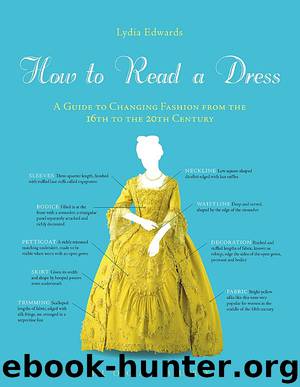How to Read a Dress by Lydia Edwards

Author:Lydia Edwards
Language: eng
Format: epub
ISBN: 9781474286251
Publisher: Bloomsbury
Published: 2017-03-14T04:00:00+00:00
This red russet day dress was purchased at department store David Jones. This establishment remains one of the oldest continuing such stores in the world and is also historically a good indicator of the position of Australia’s cities as forward-moving centers of fashion despite their distance from the sartorial capitals of London and Paris. Its showrooms and catalogue were described by the Sydney Morning Herald in 1896 as “guarantee[ing] the satisfaction of the most fastidious taste.”8
1.Silk brocade revers flare over the sleeves, extending out from the opening of this three-layered bodice. These pleated lapels were also known as bretelles.
2.Widespread use of the sewing machine made it easier and quicker to assemble complex dresses. This meant that more time could be given to handmade surface decoration like the silk rosettes and bronze beading seen here.
3.This gored, flat-fronted skirt, gathered at the rear into a small train, is very characteristic of the period. It would have been worn over a gored petticoat with frill and flare at the hem.
4.By this time, as sleeve width reached its apex, the hems of skirts widened too, often incorporating well over five meters of fabric.
5.By the middle of the decade, we see pronounced, extended leg-of-mutton sleeves, now wider and stiffer than those of the preceding years. To maintain this shape, extra structure in the form of stiff lining (and, briefly, wire sleeve supports) was required in much the same manner as it had been for the balloon sleeve of the 1830s.
6.Fashion papers during the middle of the decade spoke of the popularity of basques “long and short” and “pointed peplums,” often described alongside a new passion for overskirts. Both can be seen in this example.9
7.Fashionable styles such as this one were no longer attainable only by the leisured classes. This was the era when “readymades” in clothing became more widely available than ever and started to break down the association of fashionable, well-made clothes with only the elite and moneyed. This shift came alongside the continuing development of the department store in Europe, America, and Australia, propagated by the needs and desires of a rising urban middle class. Although dressmakers (who, in contrast to seamstresses, also designed clothing) were still in high demand, the ease and availability of ready-to-wear clothing highlighted a faster pace of life and a response to growing consumer demands.
Dress,
1897, Los Angeles County Museum of Art
Download
This site does not store any files on its server. We only index and link to content provided by other sites. Please contact the content providers to delete copyright contents if any and email us, we'll remove relevant links or contents immediately.
Tokyo Geek's Guide: Manga, Anime, Gaming, Cosplay, Toys, Idols & More - The Ultimate Guide to Japan's Otaku Culture by Simone Gianni(2314)
Batik by Rudolf Smend(2123)
Life of Elizabeth I by Alison Weir(2025)
The Little Book of Bettie by Tori Rodriguez & Dita von Teese(1623)
Vogue on: Dolce & Gabbana by Luke Leitch(1592)
Vogue on: Manolo Blahnik by Chloe Fox(1517)
Paris Undressed by Kathryn Kemp-Griffin(1453)
A Victorian Lady's Guide to Fashion and Beauty by Mimi Matthews(1369)
How to Dress by Alexandra Fullerton(1342)
Pretty Iconic by Sali Hughes(1317)
Indigo by Catherine E. McKinley(1261)
The Light of the World by Elizabeth Alexander(1216)
101 Things I Learned in Law School by Matthew Frederick(1175)
The Language of Fashion by Barthes Roland(1163)
Lazy Perfection by Jenny Patinkin(1148)
Fashion Victims by Alison Matthews David(1147)
Fashion Illustration 1920-1950 by Walter T. Foster(1134)
House of Versace: The Untold Story of Genius, Murder, and Survival by Ball Deborah(1124)
Face Paint: The Story of Makeup by Lisa Eldridge(1102)
